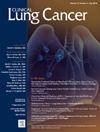非小细胞肺癌分期指南一致性治疗对生存期的影响:一种新的质量指标
IF 3.3
3区 医学
Q2 ONCOLOGY
引用次数: 0
摘要
在澳大利亚,肺癌占所有癌症新诊断病例的 9%,是导致癌症死亡和加重癌症负担的主要原因。临床实践指南为最佳实践管理提供了循证治疗建议。我们的目的是确定指南协调治疗(GCT)的实施程度,并确定影响GCT接受率和生存率的可变因素。数据来源于澳大利亚维多利亚州的维多利亚肺癌登记处(VLCR)。根据治疗类型使用描述性统计来总结患者和疾病特征:GCT与非GCT与未接受/拒绝治疗。统计分析包括多重逻辑回归、多重 COX 回归和 Kaplan-Meier 生存估计。52%的患者接受了GCT治疗,32.8%接受了非GCT治疗,15.2%拒绝或未接受治疗。接受GCT治疗的患者年龄较轻、从不吸烟、无合并症、表现较好、癌症处于早期、在多学科会议上讨论过或在较高水平的医院接受过治疗。总体而言,与未接受GCT治疗的患者相比,接受GCT治疗的患者的死亡风险降低了24%。影响接受GCT可能性的可变因素包括年龄、吸烟状况和治疗医院的特征。研究发现,一些可改变的变量对生存率有积极影响,包括增加对老年人的治疗、戒烟、提供 GCT 以及在治疗量较大的医院进行治疗。GCT 的测量和报告对生存率有积极影响,因此在报告肺癌质量和安全结果时值得考虑将其作为一项循证质量指标。本文章由计算机程序翻译,如有差异,请以英文原文为准。
Stage-Specific Guideline Concordant Treatment Impacts on Survival in Nonsmall Cell Lung Cancer: A Novel Quality Indicator
Background
Lung cancer in Australia contributes 9% of all new cancer diagnoses and is the leading cause of cancer death and burden. Clinical practice guidelines provide evidence-based treatment recommendations for best practice management. We aimed to determine the extent of delivery of guideline-concordant treatment (GCT) and to identify modifiable variables influencing receipt of GCT and survival.
Methods
Data was sourced from the Victorian Lung Cancer Registry (VLCR) in Victoria, Australia. Descriptive statistics were used to summarize patient and disease characteristics according to treatment type: GCT versus non-GCT versus no/declined treatment. Statistical analyses included multiple logistic regression, multiple COX regression and Kaplan-Meier survival estimates.
Results
52% of patients were treated with GCT, 32.8% non-GCT and 15.2% declined or received no treatment. GCT treated patients were younger, never smoked, had no comorbidities, had better performance status, had early stage cancer, were discussed at a multidisciplinary meeting or had treatment at a higher volume hospital. Overall, patients that received GCT had a 24% lower risk of mortality compared to patients that received non-GCT.
Conclusion
Modifiable variables impacting likelihood of receiving GCT included age, smoking status and treating hospital characteristics. Several modifiable variables were identified with positive impacts on survival including increased treatment of the elderly, smoking cessation, delivery of GCT, and treatment in higher volume hospitals. The measurement and reporting of delivery of GCT has positive impacts on survival and therefore merits consideration as an evidence-based quality indicator in the reporting of lung cancer quality and safety outcomes.
求助全文
通过发布文献求助,成功后即可免费获取论文全文。
去求助
来源期刊

Clinical lung cancer
医学-肿瘤学
CiteScore
7.00
自引率
2.80%
发文量
159
审稿时长
24 days
期刊介绍:
Clinical Lung Cancer is a peer-reviewed bimonthly journal that publishes original articles describing various aspects of clinical and translational research of lung cancer. Clinical Lung Cancer is devoted to articles on detection, diagnosis, prevention, and treatment of lung cancer. The main emphasis is on recent scientific developments in all areas related to lung cancer. Specific areas of interest include clinical research and mechanistic approaches; drug sensitivity and resistance; gene and antisense therapy; pathology, markers, and prognostic indicators; chemoprevention strategies; multimodality therapy; and integration of various approaches.
 求助内容:
求助内容: 应助结果提醒方式:
应助结果提醒方式:


